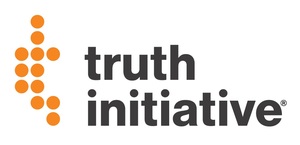WASHINGTON, Dec. 17, 2018 /PRNewswire/ -- The teen smoking rate has fallen to an all-time low of 4.6 percent, according to the Monitoring the Future survey released today. This is a remarkable milestone for public health. But as the end of the youth cigarette smoking epidemic is in reach, another has taken hold with an astounding 19.2 percent of youth now using e-cigarettes — an increase of 60 percent over 2017. It is bittersweet that while we are celebrating a tremendous win for public health, we are facing a ticking time bomb of youth nicotine addiction. The epidemic spread of e-cigarettes, primarily via JUUL, risks a reversal of our progress given that young people who vape are four times more likely to begin smoking cigarettes in the future. We are potentially swapping one epidemic for another.
Truth Initiative® is proud to have contributed to the significant decline in youth cigarette use through our tobacco public education campaign, truth®, which has prevented millions of young people from becoming smokers, including 2.5 million in the past three years alone. However, that victory is at risk of being short lived as teen current e-cigarette use is nearly as high as the 23 percent teen smoking rate when truth began in 2000. It is frustrating that after all our years of progress, we have another fight on our hands to keep a new generation of youth from being addicted to nicotine.
These numbers may encourage some to speculate that the rapid increase in youth e-cigarette use has caused the teen smoking rate to drop and is a justifiable price to pay. We strongly disagree. The decline in cigarette use in no way makes it OK that we have more than 20 percent of 12th-graders, more than 16 percent of 10th-graders and 6 percent of 8th-graders, who inhaled a highly addictive substance via a product whose long-term safety remains unknown. In fact, preliminary data from the National Youth Tobacco Survey, as reported in various news stories and expected to be released early next year, indicate a slight increase in youth smoking from 7.6 percent in 2017 to 8.1 percent in 2018. These conflicting data indicate we must keep a close eye on the relationship between youth e-cigarette and cigarette use, and re-emphasize that no nicotine use is appropriate for our kids.
The FDA's most recent announcement of proposed steps to prevent youth tobacco use are a step forward, but the agency must act quickly. While the FDA delays, the top-selling e-cigarette JUUL continues to take a page out of Big Tobacco's playbook, putting money toward lobbyists instead of peer-reviewed research to prove their product helps adult smokers quit. Most recently, reports indicate that JUUL is developing new products that deliver nicotine more efficiently as a means to evade international restrictions on nicotine content. According to news reports, JUUL is even contemplating a partnership with Altria — makers of Marlboro, America's No. 1 cigarette brand — an adjudicated racketeer that for decades made it its business to recruit youth "replacement smokers" for the 1,300 people that die each day from tobacco. History is repeating itself as e-cigarette companies increasingly emulate the past behavior of Big Tobacco.
The survey released today is yet another proof point for the FDA to take aggressive action on e-cigarettes and fully regulate these products by requiring manufacturers to submit evidence that they benefit public health before they are in every high school in America. The FDA must also end online sales, restrict marketing practices that attract youth and eliminate the panoply of youth appealing flavors that run the gamut from mint to mango to "unicorn vomit" and "strawberry shortcake." Protecting youth also requires soonest possible action on the proposed menthol cigarette ban announced by FDA Commissioner Scott Gottlieb a month ago.
States can help as well via proven strategies such as higher taxes, flavor bans, smoke-free air laws and Tobacco 21 policies in order to prevent initiating a new generation into nicotine addiction. These policies are especially needed in a significant portion of the country we've termed "Tobacco Nation," where smoking prevalence exceeds the national average and citizens remain unprotected by proven tobacco control policies.
The University of Michigan's Monitoring the Future study tracks trends in substance use among students in 12th, 10th and 8th grades. Each year, the national study surveys 40,000 to 50,000 students in about 400 public and private secondary schools throughout the United States.
About Truth Initiative®
Truth Initiative is a national public health organization that is inspiring tobacco-free lives and building a culture where all youth and young adults reject tobacco. The truth about tobacco and the tobacco industry are at the heart of our proven-effective and nationally recognized truth® public-education campaign, our rigorous and scientific research and policy studies, and our innovative community and youth engagement programs supporting populations at high risk of using tobacco. The Washington, D.C.,-based organization, formerly known as Legacy, was established and funded through the 1998 Master Settlement Agreement between attorneys general from 46 states, five U.S. territories and the tobacco industry. To learn more about how Truth Initiative speaks, seeks and spreads the truth about tobacco, visit truthinitiative.org.
SOURCE Truth Initiative
Related Links
WANT YOUR COMPANY'S NEWS FEATURED ON PRNEWSWIRE.COM?
Newsrooms &
Influencers
Digital Media
Outlets
Journalists
Opted In




Share this article